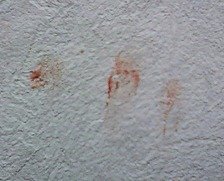Blood Fingerprint
by Christi
(Florida)

Photo Credit: sarah_pants
If a blood fingerprint was found at a crime scene. Can you determine how old the blood is?
Quality Information on Blood Fingerprints
The following information and video was sourced from the website of Mark Webster (Forensic Scientist, Expert Witness and Forensic Science Consultant).
"A "bloody fingerprint", a fingerprint laid down by someone with blood on his hands, is often very powerful incriminatory evidence.
A suspected bloody print may need to be visually enhanced to reveal features of the fingerprint that might not be immediately visible. Often, it is these otherwise invisible features that link the fingerprint to one individual. At the same time, it is necessary to establish the nature of the substance of the fingerprint. Is the ridge detail forming the print made in blood printed onto the surface, the blood and the print laid down in one unique event? Alternatively, is the print made in some other substance that looks like blood? Is it a fingerprint in some other substance that has been deposited on a surface previously or subsequently contaminated with blood?
Police fingerprint experts and technicians often enhance apparent bloody fingerprints with simple protein dyes, such as amido black. These dyes can enhance the appearance of a bloody fingerprint. However, they do not prove that a fingerprint is made in blood because they will also enhance the appearance of fingerprints made in other substances such as some foodstuffs.
Techniques exist that can establish a fingerprint as a bloody fingerprint. The techniques involve treatment with reagents that more or less specifically react to blood alone - such as diaminobenzidene, leuco-crystal violet etc. These reagents visually enhance a bloody fingerprint, revealing otherwise invisible fingerprint ridge details, whilst at the same time more or less establishing that the ridge detail is made of blood - establishing the print as a true bloody fingerprint.
Having established that a fingerprint is made in blood, it may then be necessary to DNA profile the blood making up the ridge detail to establish from whom it originated.
Depending on how much blood is present in the fingerprint, treatment with enhancing reagents may prevent successful DNA profiling. However, if a forensic scientist and a fingerprint expert work in close co-operation, it will usually be possible to adopt a strategy of investigation that does allow both enhancement and DNA profiling of the blood making up the bloody fingerprint. These investigations are best carried out in specialist units employing both forensic scientists and fingerprint experts."
Blood Fingerprint Video
(www.forensic-science.co.uk)
Related Information on The All About Forensic Science Website
Forensic Serology